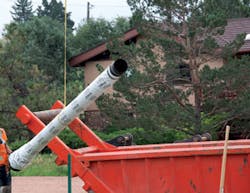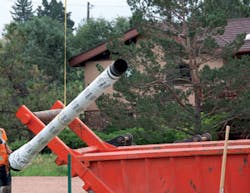By Jon Runge
For more than a half-century, polyethylene encasement has been used to protect thousands of miles of cast and ductile iron pipelines throughout North America and across the world. Now, the Ductile Iron Pipe Research Association (DIPRA) has introduced the V-Bio product, a new generation of polyethylene encasement that adds an active component to its protection.
The V-Bio product is a three-layer, co-extruded polyethylene encasement that is enhanced with a biocide and corrosion inhibitor. Meeting all of the requirements of the American Water Works Association's standard for polyethylene encasement (ANSI/AWWA C105/A21.5), the V-Bio encasement actively repels the anaerobic bacteria that can have a negative influence on corrosion rates (microbiologically influenced corrosion, or MIC) and would inhibit the development of corrosion cells under the encasement if it were to occur.
Moreover, because of the way they work, these two additives are not diminished while protecting the pipe. Today's ductile iron pipe is the most efficient, cost-effective, durable, and versatile pipe in the market, and the V-Bio product is an example of the industry's constant and continuing innovation.
One of the first public projects to test the long-term performance of the V-Bio encasement in an operating water system was installed this summer in the city of Colorado Springs, Colo. In cooperation with Colorado Springs Utilities, DIPRA installed corrosion probes over one section of a V-Bio-encased, cathodically-protected, 8-inch water main at two locations.
At each location, two corrosion probes were installed under the film (one connected to the cathodic protection system and one not connected), and the third probe was directly installed into the native soil. Over time, readings will be taken to measure how well the V-Bio encasement protects the pipe, and at some point the pipeline will be exposed and inspected, and the V-Bio encasement will be tested to ensure its continuing ability to perform.
DIPRA has also extensively studied the first known installation of polyethylene encasement in 1958 in Lafourche Parish, La. In cooperation with Lafourche Parish Water District #1, DIPRA inspected this 4-inch cast iron pipe installation eight times over the last 56 years, with each inspection demonstrating the excellent protection offered by traditional polyethylene encasement.
In Colorado Springs, readings were taken in order to establish a baseline for future measurements. The soil was tested to document its corrosivity, and the V-Bio encasement was tested for its physical characteristics and the presence of the additives. For the next several years, regular readings will be recorded and the data will be added to DIPRA's corrosion database.
Based on published research by one member company, U.S. Pipe and Foundry Company, DIPRA anticipates that the V-Bio product will meet or exceed performance expectations. DIPRA is also planning additional research in four test sites as well as more pilot studies with utilities throughout the United States.
About the Author: Jon Runge is president of the Ductile Iron Pipe Research Association (DIPRA), a group dedicated to providing accurate, reliable engineering information about ductile iron pipe to a wide variety of utility and consulting engineers. Runge has more than 25 years of marketing and management experience, having served in senior positions at brewing giant MillerCoors and the American Water Works Association, the world's largest nonprofit, scientific and educational association dedicated to managing and treating water.
More WaterWorld Current Issue Articles
More WaterWorld Archives Issue Articles




